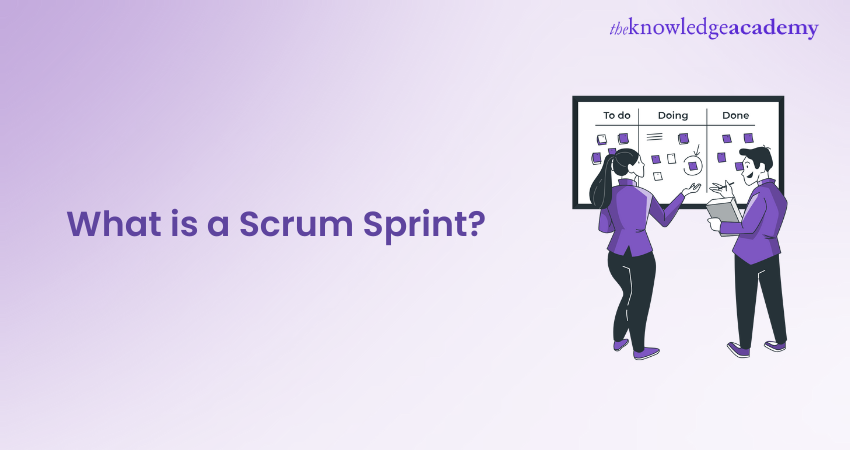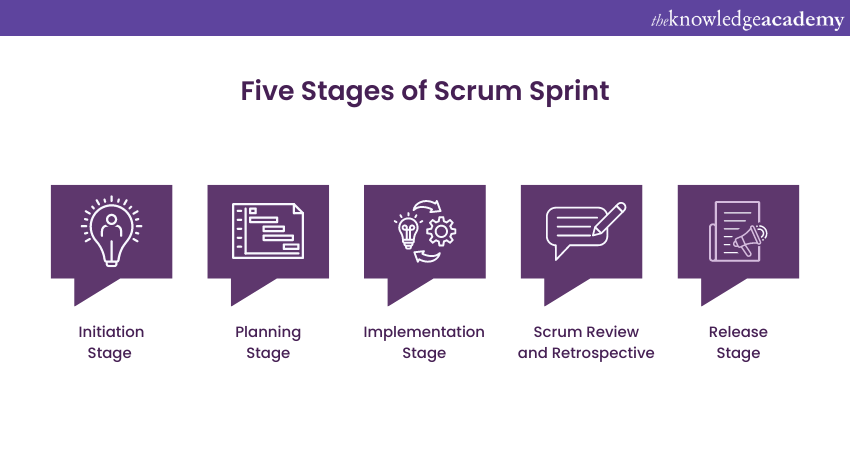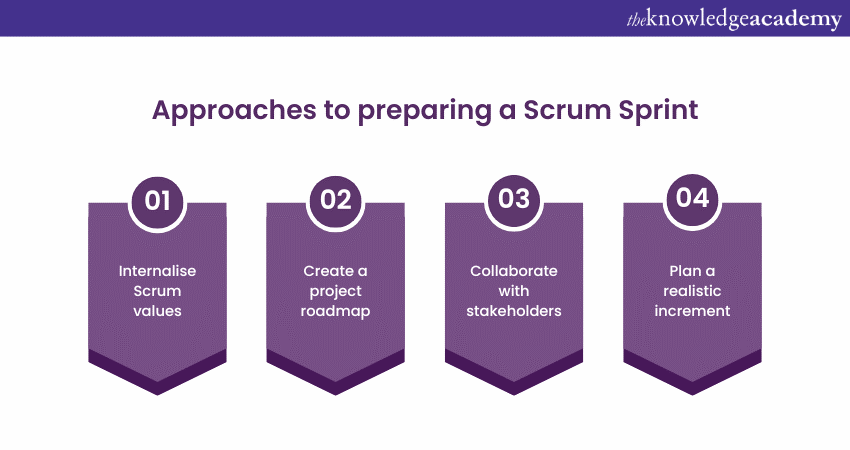We may not have the course you’re looking for. If you enquire or give us a call on +1 7204454674 and speak to our training experts, we may still be able to help with your training requirements.
Training Outcomes Within Your Budget!
We ensure quality, budget-alignment, and timely delivery by our expert instructors.

Ever wondered how the most successful tech giants maintain momentum in their projects? The secret lies in Scrum Sprints, the heartbeat of agility that propels teams towards their goals with precision and speed. According to the KPMG Global Agile Survey 2019, 78% of organisations use Scrum to simplify their work and help improve overall efficiency and effectiveness.
Be it setting clear objectives or delivering incremental value, Scrum Sprints empower teams to iterate quickly and respond to change effectively.
This comprehensive blog will delve into the intricacies of Scrum Sprints and help you master this pivotal aspect of Project Management. Let’s dive in to explore the strategies that transform visions into tangible results.
Table of Contents
1) What is a Scrum Sprints?
2) Stages of a Scrum Sprint
3) Benefits of Scrum Sprints
4) How should a Scrum Sprint be prepared?
5) Conclusion
What is a Scrum sprints?
Scrum Sprints are an essential component of the Scrum Agile Project Management framework. A Sprint in Scrum is a time-boxed period, also known as a Scrum timebox, of one to four weeks during which a Development Team works on tasks to create a potentially shippable Product Increment.
It should be brief, focused, and highly collaborative. These provide a structured approach to Product Development, allowing teams to plan, execute, and review their work regularly. It encourages transparency, inspection, and adaptation, allowing teams to continuously learn and iterate on their work.
It enables teams to create incremental value and respond to changing requirements in an agile and efficient manner by breaking the development process down into tiny and manageable chunks.
How many days does a normal Scrum Sprint last?
The number of Scrum Sprints required for a project can change depending on the project's scale and team goals established during Sprint planning. The number of Sprints can range from as few as two to three to as many as 10-20 Sprints. There is no universal number that can be applied to all projects.
What is a Sprint and how does it relate to Scrum?
Scrum serves as an expansive framework that enables the integration of Agile principles and values into everyday tasks. It encompasses a comprehensive set of ceremonies (meetings), artifacts (outputs), processes (such as inspection, adaptation, and the review of past Sprints), and roles, providing all the necessary components for Agile implementation.
Within the Scrum framework, a Sprint is a fundamental element. It acts as the focal point around which all ceremonies revolve. However, a Sprint itself is a multifaceted process comprising several essential phases.
Stages of a Scrum Sprint
A Scrum Sprint has several stages, from initiation, planning, and implementation to the Sprint review and release. When the Sprint begins, the team collaborates to complete the tasks on the Sprint backlog.
Daily Scrum Meetings help review progress, identify and address any obstacles, and ensure team members' alignment. A Sprint review, at the end of the Sprint, shows stakeholders the completed work, and a Sprint retrospective is held to reflect on the team's performance and identify areas for improvement.
Here is a breakdown of all the stages of Scrum Sprint.

Initiation Stage
The Scrum Team holds a Sprint planning meeting at the start of each Sprint to decide on the Sprint's goals and work. The Product Owner, a representative of the client or stakeholder, presents the team with the top priorities from the Product Backlog.
The team goes over and discusses the items, clarifies the requirements, and estimates the time it will take to complete them. Based on this discussion, the team decides which items to work on during the Sprint, creating a Sprint Backlog and establishing a Sprint goal.
Planning stage
Now that the Scrum goal and the scope are established, this stage is all about planning how to achieve the goals. It also includes the estimation of time and the resources required. However, it’s crucial to have a set plan so that there is a benchmark to compare the actual progress and adjust accordingly.
The Scrum team must clearly understand the project requirements. The result of this stage should be the Sprint Backlog which details the prioritised list of tasks that needs to be achieved.
Implementation stage
This is the stage where the actual work starts. Here the team uses the Scrum framework to follow the track of the progress of their work. When the Sprint begins, the team collaborates to complete the tasks listed in the Sprint Backlog. They self-organise and collaborate to deliver the product in stages. The team adheres to the Agile principles of transparency, inspection, and adaptation, reviewing their progress regularly and adjusting as needed. During a Sprint, the team discusses work progress daily to spot any bottlenecks or challenges that might affect the work progress.
Scrum review and retrospective
This stage is for reviewing all the work that's been done and assessing if the team has met the Scrum goals. The Team Leader leads the Scrum review, and the team looks at their work to see if all the tasks from the Scrum Backlog have been completed. The Scrum moves on to the next stage, when the tasks are completed.
If the Scrum goals are not met, the team moves onto the retrospective phase. A Scrum retrospective is held before the next Scrum planning to understand what practices worked and what didn't work. The goal is to take feedback and apply the learnings to improve the next Scrum Sprint.
Release stage
The release phase in Scrum refers to the final stage of a Sprint in which the Scrum team prepares to deliver the Product Increment to the customer or end-users. During the release phase, the team ensures that the Product Increment is ready for release, fits the agreed-upon Definition of Done, and is of adequate quality for deployment.
This may entail performing extra testing, addressing outstanding issues or flaws, and completing all documentation and other deliverables. Coordination with stakeholders such as the Product Owner, customers, and other relevant parties to plan and schedule the product's release is also part of the release phase.
Develop Project Management skills using the Scrum Framework with Scrum Developer Training now!
Benefits of Scrum Sprint
Scrum Sprint has several benefits that can improve project outcomes when it is implemented successfully.
Increased productivity and focus
Scrum Sprint is a focused process, and the set goals are completed within a timeframe. This leads the team to perform efficiently and enables continuous improvement. Typically, a Scrum Sprint breaks a larger task into smaller tasks, and the complete team has one common goal. This decreases distraction and increases focus.
Transparency
Scrum Sprint is based on collaboration; everyone involved is open to addressing concerns and sharing ideas. This makes the Scrum team accountable and transparent throughout the process.
Flexibility
Agile Scrum is flexible enough to make changes and adapt to changing requirements and customer feedback. This is one of the biggest benefits of using Scrum Sprints, and it enables companies to modify their operations on the go and achieve their business objectives.
Understanding Scrum
The Sprint is a crucial Scrum event that encompasses all the other events in Scrum. It involves fixed-length work periods lasting for one month or less, aiming to create consistency and ensure short feedback iterations. The feedback enables inspection and adaptation of how work is done and what is being worked on.
After the conclusion of the previous Sprint, a new Sprint starts immediately. All the work required to achieve the product goal, including Sprint retrospective, Sprint review, daily Scrums, and Sprint planning, occurs within the Sprints. Scrum Sprint has several benefits that can improve project outcomes when it is implemented successfully. Let's explore some of the Advantages of Scrum:
Learn about the key Scrum and Scrum Master techniques with our Scrum Master Certification. Sign up for the course now!
How should a Scrum Sprint be prepared?
Let us go over points to help you prepare for your first Sprint:

a) Internalise Scrum values: As a team, it is important to internalise the Scrum values. This will help your team to take charge and self-organise more effectively. Teams with a better understanding of these values will likely encounter fewer issues as better communication and collaboration are facilitated.
b) Create a project roadmap: To create a project roadmap, the Product Owner should collaborate with stakeholders to establish high-level goals, priorities, and a flexible timeline. It is important to remember that Agile methodology involves adaptation, so the roadmap should be adjusted as the project progresses. Therefore, it is optional for the roadmap to be fully developed or perfect from the outset. Additionally, it is recommended to visualise the roadmap for better clarity.
c) Collaborate with stakeholders: The Product Owner and team must work with stakeholders to add, review, and prioritise Product Backlog items. Collaborating with clients, internal users, and other stakeholders is the only way to determine the most important features. A shareable Product Backlog template can be useful in this process.
d) Plan a realistic increment: Planning a realistic increment for your team based on their capacity is important. Some teams may think that a Sprint will magically help them accomplish more in a shorter period of time, but the key to success is setting achievable goals and keeping a narrow focus. Before planning the Sprint, the Scrum team should evaluate their capacity. One Story Point (SP) should roughly equal a single workday. For a two-week Sprint, planning for "only" 8 SP is advisable to allow ample time to overcome any obstacles.
How many Sprints comprise a Scrum Project?
There is no specific or "perfect" number of Sprints that should be included in a project. The number of Sprints required depends on the scope of the project. For instance, if your project lasts for 12 weeks, it is commonly recommended to have four to six Sprints. It is worth noting that longer projects typically necessitate more Sprints to complete. This leads us to the different stages that are involved in the Sprint process.
Learn about the key Scrum and Scrum Master techniques with our Scrum Master Certification - sign up for the course now!
Conclusion
Scrum Sprints are vital to Agile Project Management because they allow teams to work iteratively and incrementally to deliver valuable Product Increments. It gives the teams the flexibility and adaptability to respond to changing needs and deliver high-quality products. Teams can improve transparency, collaboration, and customer satisfaction by utilising Sprints, resulting in more successful project outcomes.
Learn how to effectively communicate with a Scrum team; sign up for our Scrum For Teams Training now!
Frequently Asked Questions

A sprint in Scrum is a time-boxed iteration for completing work. When it's over, the team reviews progress and plans the next sprint.

The number of sprints in a Scrum project varies based on project scope and requirements. Projects typically consist of multiple sprints, iteratively delivering increments until completion.

The Knowledge Academy takes global learning to new heights, offering over 30,000 online courses across 490+ locations in 220 countries. This expansive reach ensures accessibility and convenience for learners worldwide.
Alongside our diverse Online Course Catalogue, encompassing 17 major categories, we go the extra mile by providing a plethora of free educational Online Resources like News updates, Blogs, videos, webinars, and interview questions. Tailoring learning experiences further, professionals can maximise value with customisable Course Bundles of TKA.

The Knowledge Academy’s Knowledge Pass, a prepaid voucher, adds another layer of flexibility, allowing course bookings over a 12-month period. Join us on a journey where education knows no bounds.

The Knowledge Academy offers various Project Management Courses, including Scrum Master Certification Course, Scrum Product Owner Training and Scrum Developer Training. These courses cater to different skill levels, providing comprehensive insights into Scrum Development Team Roles and Responsibilities.
Our Project Management Blogs cover a range of topics, offering valuable resources, best practices, and industry insights. Whether you are a beginner or looking to advance your Project Management skills, The Knowledge Academy's diverse courses and informative blogs have you covered.
Upcoming Project Management Resources Batches & Dates
Date
 Scrum Master Certification
Scrum Master Certification
Thu 3rd Oct 2024
Thu 7th Nov 2024
Thu 5th Dec 2024
Thu 9th Jan 2025
Thu 13th Mar 2025
Thu 12th Jun 2025
Thu 7th Aug 2025
Thu 18th Sep 2025
Thu 27th Nov 2025
Thu 18th Dec 2025







 Top Rated Course
Top Rated Course.png)



 If you wish to make any changes to your course, please
If you wish to make any changes to your course, please


